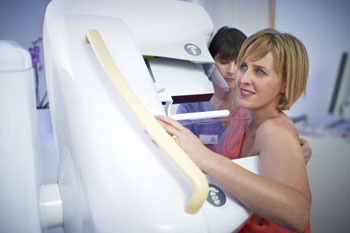Poor Positioning Responsible for Most Mammogram Deficiencies
By MedImaging International staff writers
Posted on 26 May 2016
A new report by the U.S. Food and Drug Administration (FDA, Silver Spring, MD, USA) suggests that proper patient positioning remains one of the most important aspects of high-quality mammography imaging.Posted on 26 May 2016
The FDA report notes that patient positioning according to guidelines set out in the Mammography Quality Standards Act (MQSA) is important, because only those portions of the breast, which are included on the mammographic image, can be evaluated for signs of cancer. Any portion of the breast not imaged cannot be evaluated, and cancers in those portions of the breast can be missed. The report cites a study from 2002 that found that the sensitivity of mammography dropped from 84.4% among cases with passing positioning to 66.3% among cases with failed positioning.

Image: A woman undergoing a mammogram (Photo courtesy of the FDA).
The report also clarified that although the technologist performs the mammogram, the responsibility for correct positioning is shared by the technologist and the interpreting physician, and emphasizes that the physicians are the final arbiters of the quality of mammography images, and that they should communicate their satisfaction or dissatisfaction with the quality of the images. According to the FDA, this is the crucial first step in the identification of problems and the initiation of corrective actions.
Technologists should also be trained in proper positioning, and should seek feedback from fellow technologists and interpreting physicians. Since the consequences of poor positioning can be very significant not just for individual patients, but for mammography facilities as well, affecting their MQSA accreditation, the physicians should in turn review the elements of proper patient positioning, and give constructive feedback to technologists on the mammograms that are presented to them for interpretation.
The MQSA, passed in 1999, is the primary mechanism for enforcing compliance with quality standards for mammography facilities. The FDA reports that as of May 1, 2016, there were a total of 8,738 certified facilities in the United States sporting a total of 16,042 accredited units. Of those certified facilities, 8,493 had full field digital mammography (FFDM) units.
Related Links:
U.S. Food and Drug Administration














